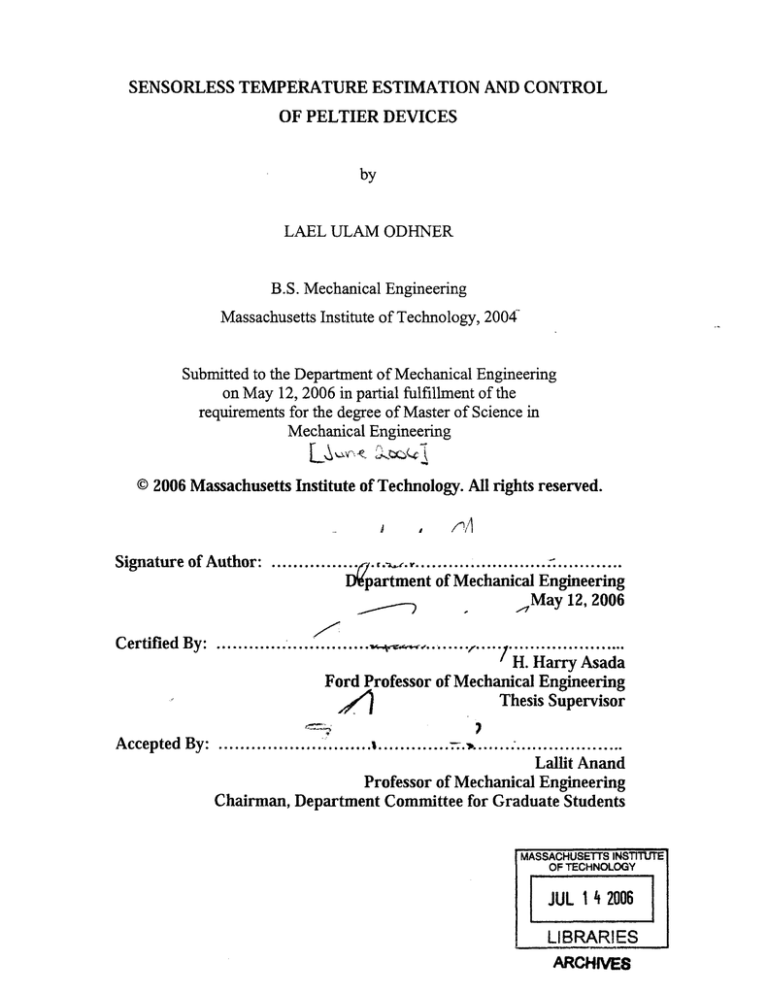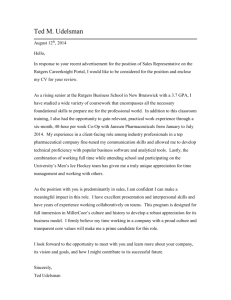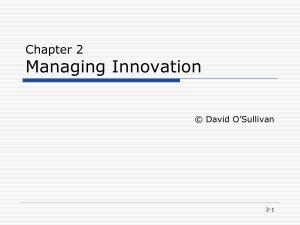
SENSORLESS TEMPERATURE ESTIMATION AND CONTROL
OF PELTIER DEVICES
by
LAEL ULAM ODHNER
B.S. Mechanical Engineering
Massachusetts Institute of Technology, 2004'
Submitted to the Department of Mechanical Engineering
on May 12, 2006 in partial fulfillment of the
requirements for the degree of Master of Science in
Mechanical Engineering
2006 Massachusetts Institute of Technology. All rights reserved.
Signature of Author: .............
..
.
...................................
Dapartment of Mechanical Engineering
-,May 12, 2006
Certified By: .................. ....... .
.......... ... T ...........
H. Harry Asada
Ford Professor of Mechanical Engineering
Thesis Supervisor
Accepted By: .........................................
Lallit Anand
Professor of Mechanical Engineering
Chairman, Department Committee for Graduate Students
MASSACHUSETTS INSTITUTE
OF TECHNOLOGY
JUL 1 4 2006
LIBRARIES
ARCHIVES
SENSORLESS TEMPERATURE ESTIMATION AND CONTROL
OF PELTIER DEVICES
by
LAEL ULAM ODHNER
Submitted to the Department of Mechanical Engineering
on May 12, 2006 in partial fulfillment of the
requirements for the degree of Master of Science in
Mechanical Engineering
Abstract
Peltier devices, also known as thermoelectric devices (TEDs), are solid state
junctions of two dissimilar materials in which heat transfer and electrical conduction are
coupled. A current running through a TED causes heat to flow; likewise, the presence of
an external temperature gradient will induce an electrical potential across the TED. The
former effect is known as the Peltier effect; the latter is known as the Seebeck effect.
While TEDs are used primarily as heat pumps, they can also serve as temperature
sensors. This thesis presents the design for a controller which uses a TED to
simultaneously sense and control the temperature of a shape memory alloy (SMA) wire.
The pulse width-modulating driving circuitry in the controller is capable of measuring the
undriven voltage across the TED at a rate of 200 Hz between pulses. A low order ARX
model is then used to estimate the SMA temperature. The SMA temperature can be
controlled using this estimate. This method will enable the production of large arrays of
TED-driven SMA tendon actuators, particularly for large DOF robotic systems.
Thesis Supervisor: H. Harry Asada
Title: Ford Professor of Mechanical Engineering
2
Table of Contents
Table of Contents ................................................................................................................
3
1
Introduction.................................................................................................................
4
2
Controller and Actuator Design. ..............................................................................
7
3
2.1
Electronic Circuit D esign ................................................................................
2.2
Thermal System Design......................................10
2.2
T erm al System Design................................................................................
2.2
Thermal System Design......................................12
2.3
Final Hardware Notes.................................................................................
M odel Developm ent.
..... .....................................
3.1
Steady-State M odel...........................................................................................
3.2
Dynam ic M odel.. ............................................
......................................
7
11
14
15
15
..........................................
17
4
Experim ental Results .............................................................................................
23
5
Conclusion ................................................................................................................
25
References.........................................................................................................................
26
3
1
Introduction
Of the many smart actuator materials currently available, shape memory alloys
(SMAs) continue to provide unrivalled energy density due to actuation stresses of over
150 MPa. Because SMA actuators operate by means of a temperature-induced solid-solid
phase transition, control performance hinges on the speed and accuracy of heating and
cooling the actuator material. The control of SMA temperature is consequently of great
interest to the SMA research community.
This thesis focuses in particular on the use of solid-state heat pumps known as
thermoelectric devices (TEDs) to heat and cool SMA actuators. In the past, several
research groups have explored TEDs as a potential means of driving SMA wires [1]-[3].
Numerous practical benefits arise from the use of TEDs to actuate SMA wires. Most
importantly, TEDs are bidirectional heat pumps, so unlike resistive heating, they can cool
SMA wires quickly, thereby decreasing actuator response times [1]. Since TEDs are solid
state devices, compact and reliable actuator systems can be built, which are not degraded
by poor heat transfer rate of air cooling and are free of messy liquid coolants in contact
with the SMA wires. Additionally, the external heating provided by TEDs does not
depend on the resistance of the SMA wires, unlike Joule heating. However, open loop
current driving of TEDs does not provide adequate control over SMA temperature [4]. In
order to achieve precision control of an SMA wire via thermoelectric heating and
cooling, this paper aims to develop a methodology for measurement and control of the
SMA temperature.
The authors were motivated by the need for a controller for a five-fingered robotic
hand with SMA actuators driven by TEDs [5]. As shown in Fig. 1, many SMA wires are
laid across an array of TEDs, where each SMA axis is connected to a tendon that
activates an individual joint of the robotic hand. Twelve axes of SMA actuators are
housed in a compact case, which is as thin as a few printed circuit boards. A salient
feature of this TED-based SMA drive is that each column of TEDs along a SMA wire
allows for local and selective heating and cooling of individual segments of the SMA
4
wire [5]. The total displacement of a SMA actuator is controlled by varying the number
of SMA wire segments which are heated into the Austenitic phase or cooled into the
Martensitic phase. Thanks to the bi-stable nature of the SMA phase transition, this
segmented binary control is not significantly affected by the hysteresis of the SMA phase
transition, and is robust to phase transition disturbances caused by varying tensile loads
on the tendon. However, many independent temperature controllers are needed to control
the temperature of each tendon actuator. These temperature controllers were previously
implemented by placing a thermocouple at each segment, but the complexity of routing
sensor wires to each TED and the associated circuitry for reading each thermocouple
render this approach inadequate for use with a large array.
heat exchanger
TED
SMA
wire
Fig. 1. A robot hand driven by a segmented binary SMA actuator array. A grid of TEDs is used to heat and
cool the SMA wire segments. A CAD model of a single TED is shown enlarged. The SMA wires are held
in contact with the TEDs using a thermally insulating plate (not shown).
5
The innovation described in this thesis arises from the fact that TEDs are
fundamentally quite similar to thermocouples from a physical perspective. The Peltier
effect by which a TED moves heat in response to current is intrinsically linked to the
Seebeck effect by which a voltage is generated in response to a temperature difference.
Both effects result from the same material property - the relationship between charge
carrier mobility and temperature in conducting materials [6]. Because of this, it is
possible to use an array of TEDs both as temperature sensors and as heat pumps to
control the temperature of each SMA wire segment using only one temperature sensor in
the array cooling system for an external reference point.
The new control system utilizes the Seebeck effect to estimate the temperature of
the SMA by means of a dynamic model whose structure is physically motivated and
whose coefficients are subsequently obtained using least squares system identification.
This estimated temperature is then used to control the SMA temperature using
proportional feedback control. The design of the TED array and the driving circuitry is
presented in section II. Section III presents the derivation of a lumped-parameter dynamic
model of a single TED. Experimental verification of the estimation model is shown in
section IV, where it is applied to feedback control.
6
2
Controller and Actuator Design
The target application of this estimation-control technique is a twelve axis tendon
actuator for a five-fingered robot hand, as described previously in section I. Each tendon
can be controlled to one of eight different displacements, corresponding to eight identical
5 mm by 30 mm TEDs (Purchased from TE Technology, Inc.), spaced 3 mm from each
other. The axes are laid out next to each other, forming a grid of TEDs on a water-cooled
heat exchanger. The hand and a CAD model of single segment are shown in Fig. 1. The
TED temperature estimator must be accurate to within 2-3 'C over a temperature range of
50-100 'C. It is desirable to minimize the response time of the actuator, so the estimatorcontroller must respond at least as quickly as it would if controlled with an external
temperature sensor.
2.1
Electronic Circuit Design
T+V
Gate A ~ current sense
Gt
resistor
TED
Gate D
Gate C
ADC voltage
measurement points
Fig. 2. A schematic showing the H-bridge driver configuration of the TEDs. Gates A and D are closed for
heating, gates B and C are closed for cooling. Between current pulses, all gates are left open so that an
ADC can be used to measure the Seebeck voltage across the TED. A current sense resistor is placed in
series with the TED to measure driving current.
7
The control system for each TED consists of a specially designed current driver
and a sensing circuit. Current is delivered to the TED with an H-bridge amplifier to allow
bi-directional driving, as shown in Fig. 2. The amplitude of the driving current is varied
by varying the pulse width of the driving signal. Between pulses, the four transistors on
the bridge are turned off, enabling the measurement of the unconstrained voltage at both
terminals of the TED. Analog to digital converters sample the floating voltages at either
side of the TED. These measurements are then subtracted to obtain the Seebeck voltage.
While the TED is driven, the voltage across a current sense resistor in series with the
TED is sampled to measure the driving current.
-- V
1kM
TED
1 kQ
Fig. 3: Saturation due to improperly constrained voltages can be fixed using a high impedance voltage
divider connected to one of the two terminals of the TED.
One problem encountered during the development of the Seebeck voltage
measurement circuit bears mention here. While the relative voltage between the two sides
of the TED converged quickly and consistently to the Seebeck voltage, slightly uneven
current leakages in the H bridge transistors were sometimes observed to pull the floating
voltage at one terminal close to the power or ground voltage. In this case, the analog-todigital converters can be saturated, providing artificially low measurements of the
Seebeck voltage. To correct this, all that is needed is a pair of 1000 ohm resistors at one
8
terminal of the TED, one attached to power and the other to ground. These resistors act as
a voltage divider, drawing little power but enough that the uneven current leakage does
not cause the Seebeck voltage measurement to saturate.
Figure 4 shows a plot of the voltage across a TED resulting from this driving
scheme. The plot illustrates the process of switching back and forth between the sensor
and heat pump modalities. Due to the low inductance and electrical capacitance of
thermoelectric devices, the Seebeck voltage obtained with this sampling circuit is
available at relatively high time resolution. A driving/sampling rate of 200 Hertz was
selected for the finished controller.
The sensing and driving capabilities of the controller are combined in a central
processing unit, which uses the Seebeck voltage to estimate the SMA temperature TsMA.
This estimate is used to compute a proportional feedback signal, which is saturated and
converted into a pulse width for the driver, as shown in Fig. 5. The control system runs
on a Microchip dsPIC3OF2010 microprocessor clocked at 8 megahertz. The estimator
was implemented as an auto-regressive/exogenous (ARX) input model downsampled
from 200 HZ to 50 Hz for estimation and control. The pulse width modulation was
handled using the dsPIC3OF2010's built-in pulse width modulation module. The
computation required for control proved simple enough that multiple axes can be run off
of a single controller; the test apparatus was capable of performing all of the temperature
estimation and control calculations for two TEDs within 1 millisecond.
9
RPtsrtW OIEru a Acrws a PYII44~Nw PdIter Dafe
4.5
4
45
35
3
252-
251
Is.
2
6.6
1.5
dive.
6S
1I
97U~
UQ\
0.51
a
3
4
5
6
7
a
9
10
11
12
13
lime [secards]
Fig. 4. The voltage difference across a TED is measured while driving at a 50% duty cycle for 5 seconds. The changing
Seebeck voltage corresponding to an increase in temperature across the TED can be seen in the rising voltage between
pulses. The inset figure shows how the driving and sampling actions were timed.
0
Saturation
Tref
+
-*0
0
L.J
(5
PWM
Driver
2,5A
.2
Sco
XCurrent
bo +b z
Thermoelectric
Device
Sense
SapigCruit
Fig. 5: A block diagram of the control system, including the estimator.
2.2
Thermal System Design
The Seebeck effect measures the local temperature between the SMA wires on
one surface of the TED and the heat exchanger on the other surface of the TED.
Normally, the reference or "cold" junction is measured with a second thermocouple. In
this case, the common reference point for all of the TEDs is the temperature of the heat
exchanger, as shown in Fig. 6. To ensure that the temperature on this heat sink was
unifonn, the heat exchanger was made from a brass sheet several millimeters thick. The
high internal conductivity of the brass sheet ensures the uniformity of the heat exchanger
temperature, so that a single temperature measurement is a good predictor of the surface
temperature everywhere on the heat exchanger.
The heat exchanger temperature was measured using a single thermocouple
(Omega 0.25 mm diameter J-type) fastened onto the manifold using conductive heat sink
compound. Coolant water is circulated inside the heat exchanger, carrying away waste
heat rapidly enough that the heat exchanger temperature Tc could be treated as quasistationary. The SMA wire was held against the other surface of the TED with a foamed
polystyrene sheet, so that it provides an essentially adiabatic boundary condition for the
TED. For calibration and validation, the temperature of the SMA was measured using
another 0.25 mm thermocouple. The thermocouple, having the same diameter as the
SMA wires used, had contact geometry similar to an SMA wire. Consequently, it
provides an adequate measurement of the SMA wire temperature.
12
Traditional thermocouple
Hot junction
Seebeck Voltage
Cold junction
----
-------------
I
New TED array sensor
Many "hot" junctions
(AW(AW
" I-
)AW
AW)M
One effective "cold" junction
Fig. 6: The array sensor differs from a traditional thermocouple because the reference temperature is
provided by the heat exchanger temperature, rather than a second thermocouple at a known temperature.
13
2.3
Final Hardware Notes
There are multiple aspects of this thermal array hardware that can be modified to suit a
particular application while still supporting the estimator-controller models. The water
cooling, while quite effective, could be replaced with an air cooling loop, as long as the
spatial and temporal stability of the heat exchanger temperature can be guaranteed. The
most important aspects of the heat exchange system, upon which the analysis in section
III rests, are the boundary conditions at either side of the TED. The surface of the TED in
contact with the SMA must not allow heat to flow at steady state. Similarly, the surface
of the heat exchanger must be at a uniform temperature, if one sensor is to accurately
determine the absolute temperature reference for all of the TEDs. These conditions were
deliberately chosen to simplify the modeling and limit the amount of hardware necessary
to accurately predict and effectively control the temperature across the whole array.
14
3
Model Development
In order to estimate the temperature of the SMA using the heat exchanger
temperature and the Seebeck voltage, a physical model must be constructed of the
thermal behavior of the TED. Two models are presented in this section. The first, a
steady-state model resembling a conventional thermocouple measurement, is insufficient
for the purpose of control, but nonetheless is instructional and serves as a framework
from which a more comprehensive model can be built. The second model accounts for
the transient thermal response of the TED, and substantially improves the closed-loop
response time of the system.
3.1
Steady-State Model
In all thermoelectric junctions, the Seebeck voltage Vs provides information about
the local temperature difference between the two sides of the junction. This relationship
is usually described using a lumped Seebeck coefficient /1, for a mean material
temperature T [6]:
,B(T)=
yAT
(1)
)T
In many materials, fl varies little over a large enough temperature range that it can be
approximated by a constant value. In the TEDs used,
18
was observed to be constant
between 20 'C and 100 'C, so the temperature across the junction A TTED was considered
to be linearly proportional to Vs,
ATTED=
8P'K5
(2)
15
Using this relationship, the steady-state SMA temperature can be modeled as shown in
Fig. 7 as the temperature difference across the TED, A TTED, plus the temperature
difference between the common reference of the heat exchanger Tc and the temperature
at the interface between the TED and the heat exchanger, A THE,
sMAT +AT
(3)
+ATTD
THE
TED
Thermoelecti ric
HE
Device
TCQ
TSMA
QHE =2RTEDS
Fig. 7: A static model of the TED. The temperature across the TED A TTED is measurable via the Seebeck
voltage. The temperature rise due to the thermal interface resistance
RIIE is
found by computing the heat
flow QHE-
When the TED is working as a heat pump, it generates heat due to Joule heating,
proportional to the instantaneous driving current i squared and scaled by the duty cycle 5
of the pulse width-modulated input,
QHE
where
RTED
2RHE
(4)
is the lumped electrical resistance of the TED. The surface of the TED
contacting the SMA is assumed to be well enough insulated that no substantial amount of
the dissipated heat flows out. Conservation of energy then dictates that the power
dissipated within the TED due to Joule heating must be equal to the heat flowing into the
16
heat exchanger through some interface resistance
This implies that A THE=
RHE.
QHERHE.
Substituting (4) and (2) into (3) yields
TSMA=
(5)
Tc + d,,P+b,,Vs
where
P=i 2 8,
d,
=
RHERTED
bss1/1
(6)
This parameterization is useful because it makes TsMA a linear function of P and Vs. The
parameters b., and ds, are identifiable from calibration data, and can accurately predict the
steady state behavior of the system, but unfortunately (6) is an unfit for estimating a
feedback signal. The difficulty with this model is the optimism inherent in the steady
state assumption. By controlling the TED based only on the steady-state temperature
prediction, the controller cannot observe the transient lag in system response due to
thermal capacitance. Consequently, the controller does not exert any effort to cancel the
transient lag in response, and tracking performance is poor. To fix this shortcoming, some
dynamic model of the TED capacitive behavior is needed.
3.2
Dynamic Model
The transient thermal behavior of a thermoelectric junction is inherently a
continuum problem, involving the time-dependent thermal gradients within the TED
material. Nonetheless,
a simple
lumped-parameter pole and zero model of the
temperature response is desired for the purpose of control. Some bulk temperature and
capacitance simplifications must be made in modeling the TED thermal gradients in order
to do this. The capacitive thermal energy of the TED,
UTED
, can only be expressed as an
integral of the thermal capacitance of a thin cross section c(x) and the temperature
gradient T(x,t):
17
L
UTED(t)=
Jc(x)T(x,t)dx
(7)
0
In general, it is possible to separate the temperature response of a body of thickness L
undergoing transient heat conduction into a series of separable spatial and temporal
functions [7]:
T(x, t) - T(05 t) = 0(p,
T(L, t) - T(0,t)
,(t)
(8)
kO
Under sufficiently slow input conditions, the higher order terms of this series die away
over time, leaving only the lowest order response in the desired separable form. The time
constant which governs the decay of the higher-order terms is found by computing the
Fourier number, a dimensionless group written in terms of the TED material density p,
heat capacity c,, conductivity k, and thickness L:
FoO.5L
=
kt
p c, (0.5L) 2
(9)
According to the data published by the manufacturer of the TED, p = 7180 kg/m3, c,
=
179 J/kg K, k = 1.67 W/m K, and L = 1.2 mm [8]. Evaluating the above Fourier number
with these data yields FO0.5L = t/0.27 s, from which the characteristic settling time of the
temperature gradient is determined to be 0.27 seconds, significantly shorter than the
observed system response time of approximately 3 seconds. Because of this, the firstorder separable functions (po(x) andfo(t) should adequately describe the TED temperature.
18
zTTED
x=L
x=0
xI
-
TSMA
-O Tb
c(x)dx
Cb7
Fig. 8: A dynamic model of the TED. A bulk thermal capacitance assumption was used to describe the lag
in transient response due to thermal capacitance. The Seebeck voltage still accurately captures the
temperature drop across the TED; However, the heat flow from the TED into the heat exchanger depends
on the capacitive effects as well as the Seebeck voltage.
Using this in (8) yields
L
UTED (W=
L
Jc(x)p0 (x)f0 (t)dx = f0 (t) Jc(x)(o (x)dx
0
(10)
0
According to the mean value theorem, a time-invariant position x* must exist somewhere
within the TED for which the value at x * is equal to the average value of c(x) po(x):
c(x*)p 0 (x*) = LJc(x)p0 (x)dx
(11)
0
Using this value of x*, (7) can be rewritten in terms of a bulk capacitance and a bulk
temperature:
UTED(t) =
L -c(x* )g (x* )f(t) = L - c(x* )T(x*, t)
(12)
19
The bulk temperature Tb is defined as T(x*, t), and the bulk capacitance Cb is defined as
Lc(x*). Figure 5 depicts this augmented parameterization of the TED system. An energy
balance can be written for the bulk temperature in terms of Joule heating as a function of
the current duty cycle 6 and the conductive heat transfer into the heat exchanger:
UTED
Cb T(t) =
RTEDP(t)
C
RI)(
RHE
(13)
The temperature T(O, t) at the base of the TED must be directly related to the bulk
temperature and the temperature across the TED
ATTED
by means of the same separability
argument made in (11):
T (0,t) = T,(t)-aATTED(t)
(14)
where a, ranging between zero and one, is a time independent property of the temperature
gradient:
_,(t)-T(O,t) _pO(x*)-(p(O)
ATTED
qD (L) -q 0 (0)
(15)
Relating T(O, t) back to Tb and A TTED enables the construction of a differential equation
and a transfer function dependent only on the dissipative input P(t), the coolant
temperature Tc(t) and the TED temperature difference A TTED(t), which can be measured
using the Seebeck voltage:
RHE CbTb (t) +
1b (t) =
RHE RTEDP() +
Tc (t) + aA TTED (t)
Tc(s)
RTEDRIIEP(s)
RIIECbs+I
RIIFChs+l
(16)
aATTED (s)
RIIECbS
(17
The SMA temperature TsMA can be related to the bulk temperature T in a manner very
similar to (14),
20
(8)
TTED
(
Tsum (t) = T (t)+(I- a)
Equation (18) is then substituted into (17) to obtain a complete transfer function for
estimation:
(S)
T,(s)
RHECbs +I
l-a)AT(s)
a
RTEDRHEP(s)+
RHECbs+l
RHECbS +
(19)
I
Because (2) allows for the measurement of A TTED, (19) is expressible in terms of
TS"(S = I
Tc(s)
_Eb
RTEDRIIEP(S)
HA + ,6 V1 P (S)
+ +REbs+I+
RE
bs+1
RgCos+1
(1-a)RHECbS
(20)
RH
-
quantities which can be measured:
bs+
From this it can be seen that the SMA temperature is related to the inputs via a common
pole, as well as a zero in Vs. For the purpose of computation, (20) was converted to an
equivalent ARX model in discrete time. Rather than identifying
RTED, RHE, Cb
and a
directly, the coefficients of the ARX model a,, bo, b,, co, and do were treated as a new set
of model parameters, which were identified directly using least squares estimation:
TSMAJ =a,
TSMA,1-1 +cOTC , +dOP +bos, +bVs.,
(21)
This ARX model bears a striking resemblance to the steady-state model derived in (5). In
fact, the coefficients of the two models must be compatible for constant inputs. This is a
powerful observation because it greatly simplifies the process of identifying the timedependent model coefficients. The steady state model, once calibrated, can be used to
reduce the number of parameters in the transient which need to be identified, as follows:
CO
1b
=
I-a,
1-al
do
=d.
(22)
1-a,
21
When these constraints are applied to (21), the number of parameters which must be
identified in the transient case reduces to two, bo and b1 :
TT, +d, Pt - TsAlTS'V-
= Ts4At-1 +bo
Tc+_d
+VS
+ b1
-Ts_
b
+VstI)
(23)
Model order reduction using the steady state model makes parameter identification
simpler, but it has another, subtler advantage: Predictions made using this model will
have minimal steady-state error, as they are algebraically constrained to the steady-state
model. No drift in estimation will occur due to improperly identified system poles, which
is crucial to maintain accuracy in temperature control.
22
4
Experimental Results
An estimator-controller for two SMA segments was implemented using the model
of (23). Calibration of the steady-state parameters bs, and ds was performed by hand,
yielding values of 98.4 C/V for bs, and 7.37 oC/A 2 for ds. The agreement between the
calibrated static model and measured values of TsMA is shown in Fig. 9. The 95.5 percent
agreement of the TED behavior with the linear model confirms the validity of the twoterm model from (5), and also the assumption that the Seebeck coefficient
#
is constant
up to at least 100 'C.
Static Temperature Prediction Results
100
80
0
H
**0
60
060
40
.1*****
e
20
0
0
20
40
Measured TSMA,
60
80
100
O
Fig. 9: The static temperature estimator, which predicts TsmA using dissipated heat and Seebeck voltage, is
found to agree to within 95.5% with the steady-state temperature measurements.
The dynamic model parameter identification was performed onboard the
controller using an automatic calibration routine. In this way, the exact timings used by
the microcontroller were reflected in the dynamic model. The dynamic model was
compared with the tracking performance of the controller using identical gain and an offthe-shelf thermocouple as an external feedback sensor. A reference trajectory was chosen
23
typical of the desired behavior SMA actuator array, switching between 70 and 85 'C at 5
second intervals. The response, plotted in Fig. 10, shows that the estimator-controller
performs comparably to an external sensor used for feedback. Steady-state average
tracking error using a sensor was measured to be -0.9 'C; using the dynamic estimator,
the average error was -1.4 'C. A lag following each large change in the reference signal
was observed in the response of both the sensored and sensorless controllers. This lag,
which limited the maximum rate of tracking response, was caused by the output
saturation of the controller.
Figure 10 also includes a response generated by using the static estimator for
feedback control. As discussed in III, the steady state behavior of the controller is still
accurate, but the settling time is much longer than desirable.
Tracking Response Using an External Sensor
85
80
75
70
0
5
10
15
20
25
Sensorless Tracking Response Using Dynamic Estimator
an.
85
80
75
70
ft.%
3
5
10
15
20
Sensorless Tracking Response Using Steady-State Estimator
:5
90
85
80
75
70
65
0
5
15
10
20
25
Time, s
Fig. 7: The use of a dynamic temperature estimator significantly improves the controller's ability to track a
time-varying reference signal. The response plotted was measured with an external temperature sensor.
24
5
Conclusion
Most transduction effects in nature are bi-directional; the thermoelectric devices
examined in this thesis are but one example. Piezoelectric crystals are commonly
available both as pressure sensors and high-force, low-displacement actuators. Brushless
DC motors often use back-induction to measure motor speed. With the advent of
ubiquitous, low-cost computing power, the duality of many of these phenomena can be
exploited to improve cost and performance through the additional information that can be
measured or estimated.
Using the techniques described in this paper, high-DOF TED-driven SMA
actuator arrays can be constructed which can be rapidly heated and cooled without
external sensors. Because there is no longer a need to occupy TED surface area with
temperature sensors, it may be possible to significantly decrease the size of the TEDs
behind the individual SMA segments, thereby increasing efficiency and enabling the
construction of compact arrays. However, it should be noted that while this technique
was developed for the control of shape memory alloy actuators, it should be broadly
applicable to any temperature control problem involving thermoelectric devices.
25
References
[1]
Jones, J D; Shahin, A R; Meckl, P H; Thrasher, M A 1994, "Enhanced cooling of
shape memory alloy wires using semiconductor "heat pump" modules," J. Intelligent
Mater. Syst. Struct. 5, no. 1, pp. 95-104.
[2]
Bhattacharyya, A., Lagoudas, D.C., Wang, Y.C., and Kinra, V.K., 1995, "On the
Role of Thermoelectric Heat Transfer in the Design of SMA Actuators: Theoretical
Modeling and Experiment," Journal of Smart Materials and Structures, 4, pp. 252-263.
[3]
Luo, Y., Yakuma, K., Takagi, T., Maruyama, S., 2004, "Thermal responses of a
thermoelectric SMA manipulator," International Journal of Applied Electromagnetics and
Mechanics, 19, pp. 303-307
[4]
Luo, Y., Yakuma, K., Takagi, T., Maruyama, S., 2000, "A Shape Memory Alloy
Actuator Using Peltier Modules and R-Phase Transition," Journal of Intelligent Material
Systems and Structures 11, pp. 503-511.
[5]
Selden, B.; Cho, K. J.; Asada , H. H.
,
"Segmented binary control of shape
memory alloy actuator systems using the peltier effect", Proceedings of the 2004 IEEE
International Conference on Robotics and Automation, pp. 4931-4936.
[6]
Gray, P., 1960, The Dynamic Behavior of Thermoelectric Devices, M.I.T. Press
& John Wiley and Sons, New York.
[7]
Lienhard, J. H., Lienhard, J. H., 2005, A Heat Transfer Textbook, 3rd ed.,
Phlogiston Press, Lexington, MA
[8]
Lau, P., Buist, R., 1996, "Temperature and Time Dependent Finite-Element
Model of a Thermoelectric Couple," Proceedings of the 15th International Conference on
Thermoelectrics, pp. 227-233.
26






